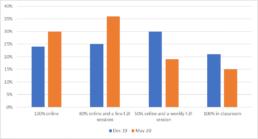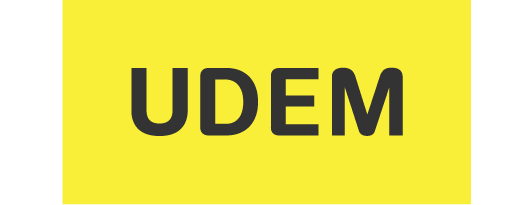Transforming from Virtual Teacher 1.0 to 2.0
Welcome to this virtual world of Teaching Online! Where you only see your students remotely and the interaction is through online tools, apps, and platforms.
Well, now that you have survived these past few months of transitioning to teaching online. I bet you are wondering what follows? What is the next step?
Here is parody of a professional sports news show on the trades and drafts of teachers.
Imagine if instead of a National Football League draft, there is a teacher draft. Which round would you be drafted in? And if the professional announcers went through a play by play of your course, what comments would they make?
The next step for you is to up your game and game plan for online teaching. Let’s see what we can do to help you transform into the Online Teacher Reloaded.
First of all, let’s go back in time and briefly review the history of online teaching.
The first courses using computer assisted instruction started with the development of P.L.A.T.O. (Programmed Logic for Automatic Teaching Operations) at the University of Illinois in 1960. Additionally, in the 1960s, Stanford University taught beginning level Russian using Computer Assisted Language Learning (C.A.L.L.). These beginning courses were based on a behaviorist approach of language learning -and teaching that used listen and repeat drills, learning vocabulary, grammar drills, and direct translation (Butler-Pascoe, 2011). Today, teachers use a more integrative approach.
Since online classes became a reality in the 1980s, which was approximately 10 years after the internet was founded, teachers have been trying to optimize the online learning, teaching environment, and course design to help students learn. Kentor summarized the history of online education with “Online educational programs emerged in 1989, when the University of Phoenix began using CompuServe, one of the first consumer online services”. (2015, 28). In the 1990s, many more universities and colleges started experimenting with the online delivery of courses.
Warschauer (1996) commented that thanks to the technological developments of multi-media computers and the Internet, virtual education as transformed from behaviorism to integrative, (Meinecke, 2020, p. 5) from memorization drills to a complete learning experience. Today, the possibilities are to infinity and beyond in virtual education.
Now, what can you do to become the Online Teacher RELOADED? Here are some suggestions of how you can continue to develop, improve, and surpass your last semester of virtual teaching.
Remember that teaching online is NOT TO DUPLICATE EXACTLY what you have done in the traditional face to face classroom. Virtual teaching and learning is much more. You can individualize instruction, students can work at their own pace, and reread and rewatch videos as many times as they need to understand, learn, and analyze a topic. Teaching online is a new way to look at education and a transformation of your course.
According to Moore and his Theory of Transactional Distance (1997) online teaching and learning is a combination of dialogue, structure, and learner autonomy. This concept describes the relationships between teacher and student that exist when teachers and students “are separated by space and /or time” (Moore, 1997, p. 1). Moore further states “It is the separation of teachers and learners that profoundly affects both teaching and learning. With separation there is a psychological and communications spaces to be crossed, a space of potential misunderstanding between the …” teacher and student. The three main ingredients of Moore’s theory are course structure, dialogue or communication between students and between teacher and students, and the degree that the student can learn on their own. Thus, this article is divided into suggestions for the course structure, dialogue, learner autonomy, and finishes with suggestions how staying updated aspect of the online teacher reloaded.
Course Structure.
First, you must have in mind a very clear picture or idea of which competencies, outcomes, goals, objectives, or skills the students will acquire, learn, and develop during the course. For example, you teach a class on human anatomy. Well, there are several ways, means, and paths to teach anatomy. You could take the path of flipped learning, gamification, or a more traditional approach. All the paths lead to the same goal which is to learn the muscles, bones, and all aspects related to anatomy. The question for you the teacher to decide, is which path to take? Second, decide on the steps the student must go through to reach those goals. (use backward design). Select activities, units, topics, etc. Develop the 6 basic areas of an online course of course organization, interaction, ease of navigation, technology, course materials – content, and assessment.
Thirdly, now that you have a very clear picture of what you want, now look at the apps and try out a few. “Choose the app that best fits your class. Not the other way around.” Burns (2020). It took me a while to realize this one. I had tried to make different content and different courses fit the app, but that does not really work efficiently.
For an advanced English course, the students create weekly video diaries. So, I decided first to use video diaries to allow students to practice oral English as well as their creativity in expressing themselves. The, I looked at padlet, flipgrid, youtube, vimeo, and several other apps. Finally, I decided students would upload the video diaries to any app, but then they had to post the link in the blackboard discussion board. My only requirement was I would only click on a video to watch it. Thus avoiding the timely task of downloading videos. I reached that decision because I had a clear idea of my objective and found the technology that worked. First comes the goal and then the technology that meets your requirements.
Students and Their Autonomy
Now, think about your students. Make it personal. How are they learning? What are their preferences?
You might have Generation Z or Millennials in your classroom today. Generation Z is currently from 10 to 24 years old while Millennials are from 24 to 39 years old. “78% Generation Z students still think teachers are very or extremely important to their learning” Pearson, 2016). 59% prefer YouTube as a top learning method and almost half of them spend 3 hours or more per day on YouTube. 47% like to use interactive apps or games to learn and take into account the different learning styles of visual, verbal, logical, auditory, social, solitary, and kinesthetic. So include various forms of learning from books, articles, videos, games, etc.
This might surprise you, because it also surprised me. In a study conducted by Meinecke last fall, over 60% of Universidad de Monterrey students still prefer textbooks and resources on paper. According to Pearson, from 46 to 60% of Gen Z and Millennials still prefer books. Remember to offer the option for students to download files to read and if they want, to print out. There is still a slight advantage of better reading comprehension for academic and more difficult texts on paper. (Clinton, 2019)
From selected sample of over 150 students from various majors and semesters, 55% of UDEM students mentioned their biggest difficulty in taking online courses is time management (Meinecke, 2020). Time management refers to schedules, remembering to submit assignments, and managing due dates. So, help them out by publishing the calendar in several formats, programming automatic reminders, and posting tips and activities on self- organization.
For help in time management, students also asked for activities and assignments to be due on a fixed date of the week. One online course that I teach has varying due dates which means sometimes an activity can be due one week on a Monday and then the next week on a Wednesday. Each week the due date is different. I learned from the surveys from Fall of 2019 and Spring 2020, that students want a fixed day of the week as a due date. So now when I sit down to read, evaluate, and grade, now Mondays are for class A, Tuesdays for class B, and so on.
Here is what your students at UDEM prefer on taking classes online versus face to face.
The December 2019 survey is pre-Covid-19 pandemic and migration to online. The May 2020 survey is after the online migration caused by the COVID-19 pandemic. The students were simply asked; how do you prefer to take your classes? Note: This survey was administered to a sample of over 150 students each semester from various majors and various semesters. The tendency of the students’ preferences is towards being online more and influenced more by the recent quarantine situation.


Dialogue
Active Communication with students is important for a successful online experience. 13% of UDEM students mentioned their biggest challenge in the interaction, specifically with the instructor and with their classmates (Meinecke, 2020). Active communication can be via messages, e-mails, synchronous sessions, announcement section, and instructor online office hours or help sessions for audio, video, or text communication. Maximize the use of the technology that is available to you for communicating.
Interactivity
Think back to the first courses offered via mail or via telesecondary… What is the difference between those first course available via mail or television and today’s online courses? Pelz (2010) describes “Interactivity is the heart and soul of effective asynchronous learning.” (p. 107). In a face to face class, teachers and students interact constantly, but in the online class, what is the level of interaction? You can increase the interaction by using effective synchronous sessions and designing activities that promote interaction such as collaborate group activities and individual activities that require discussion, collaboration, and interaction. For example, discussion boards, collaborative research project, group videos, investigations, experiments, essays, challenges, problem- solving and more for students to collaborate on. Just make sure to make it meaningful and to clarify the collaborative project rules to avoid the freeloaders in the group projects. Here is more information on organizing group projects.
Finally, Pelz further mentions that the student and faculty satisfaction is strongly linked to the “quantity and quality of student-student and student-professor interaction” (2010, p. 107). So remember the interaction when teaching and designing your next online course.
Teacher feedback
The quality and promptness of feedback is a basic ingredient of an effective online course. Leibold and Schwartz mention that “Teacher skills for giving online feedback to learners varies from giving feedback in face to face courses because non-verbal communications (tone of voice, facial expressions) are absent in written online feedback.” (2015, p. 34). Keep in mind that you may write your feedback one way and the student may read it another way. One suggestion to try is the warm – cool feedback protocol for both teacher and peer feedback. Warm feedback is a positive response on an assignment (an aspect that the student did well on) while cool feedback is constructive criticism on an aspect that the student can improve on.
Chickering and Gamson (1987) state that prompt feedback as one of the seven principles of effective teaching. Prompt feedback is important to students.
Engage students by asking for feedback
When students are allowed to give feedback and they feel like they have a voice, then students feel like they have an ownership in the course and they engage more. Plus, you can see the course from the students’ point of view. As ELT Think Tank states that “If we ask the right questions, we’ll hopefully get feedback we need to make meaningful changes in our teaching to create an effective and engaging environment.” (2018, 2). And this is so important in the online classroom and online education where feedback is delayed and there is no or little body language to read or faces to show that they understood or did not understand.
Develop into an Online teacher reloaded
Read, research, and investigate what other teachers have done.
Your fellow teachers can be an enormous inspiration and wealth of information for successful and unsuccessful teaching practices. Many psychologist, sociologists, scientists, researchers, and teachers have investigated and published their own experiences, ideas, and theories. So, read, read, read. Find and subscribe to a few bloggers or innovation experts to send you weekly ideas. This is a great way to see new innovative and creative ideas while staying up-to-date in teaching or your area of expertise.
Observe your own class / online course.
Use action research to better your course. This was coined in 1940s by Kurt Lewin. It is basically a cyclical process in which the teacher identifies a problem in the course, then creates and analyzes solutions. Next, the teacher applies the solutions and analyzes (qualitative or quantitative) the outcome. Then the cycle repeats itself again. It can be from very informal to informal process. It is a combination of taking action, researching while critically reflecting. The critical reflection is an essential key to the process. Action research is very similar to design thinking in which trial test or prototypes are tested. My recommendation is to take notes of successful and unsuccessful practices and sessions, apply surveys to get feedback from students (surveys can be as simple as a simple thumbs up or thumbs down from the students). We learn as much from our successes as from our failures. In addition, I recommend that you apply a short survey half-way through the semester to ask for student feedback and then again at the end. If you wait until the very end of the semester for student feedback, then it is too late to make modifications. When designing your poll or survey for the students, avoid asking students to grade you. It is better to ask students for the best activity, worst activity, suggestions for improvements, what aspects does the teacher do well? and What are the teacher’s weaknesses or areas to improve on? These are a few suggestions to help you observe what is happening in your courses.
Share good practices
At the end of the school year or semester, organize an event for teachers to share their good practices. Teachers teaching teachers is a great way for your teachers to develop their own expertise. “Each and every time teachers prepare a workshop or presentation for another group of teachers, their own teaching performance and effectiveness improves.” (McEwan 2003, p. 106). I have learned more from these brief presentations or round table than any other way.
Consider to also share worst experiences. Share a lesson or class that did not work (anonymously) and ask fellow teachers to give feedback on how to turn this horrible lesson into a great lesson. The famous saying of “We are only as strong as our weakest link” applies here. This means that we are only as effective as our weakest class. Plus, you can receive valuable ideas on how to improve.
Encourage an atmosphere of improvement and creativity.
Encourage your students and yourself to innovate, do trial periods, and try new things. Yong Zhao, a well-known author on global education, stated that creativity is an essential key and foundation to all human behavior and learning (as cited in Richardson et al 2017).
Remember, it takes a village to raise a child.
This is an African proverb means that many people are involved in raising one child from teaching and influencing the child about math, science, values, work, social relationships, and all the aspects we need to live, survive, and to flourish in the world. Well, this also applies to you as a teacher and your online course. It takes many professionals from different areas such as graphic design, tech support, fellow teachers, and students to raise an online teacher and to create an online course. Accept help and always ask questions.
Just as the internet has transformed from web 1.0, where users can only read internet page content, to today’s web 2.0 and 3.0, where users can now interact with the pages as well as create and participate to influence the internet. This transformation has directly impacted course design and delivery. This same transformation applies to online teaching where teachers have converted from virtual teacher version 1.0 to version 2.0 and 3.0. Now, ask yourself. which virtual teacher version are you?
These are just a few tips and information to help you on your path to becoming virtual teacher 3.0.
Thanks to all of my colleagues, department heads, students, and teaching personnel. This article is a compilation of my own experience, suggestions from fellow teachers, and theory from the experts.
References
Burns, M. (2020, May 13). 3 Tips to Make Remote Learning More Personal. Class Tech Tips. https://classtechtips.com/2020/05/13/make-remote-learning-personal/
Clinton, V. (2019). Reading from paper compared to screens: A systematic review and metaanalysis.
Journal of Research in Reading, ISSN 0141-0423 DOI:10.1111/1467-9817.12269
ELT Think Tank. (2018). How to use student feedback to improve teaching? Retrieved September 5, 2019 from https://eltthinktank.com/how-to-use-student-feedback-to-improve-teaching/
Ferrance, E. (2000). Themes in education: Action research. Providence, RI: Northeast and Islands Regional Educational Laboratory. www.lab.brown.edu.
Generation Z. (2020, May 20). In Wikipedia. https://en.wikipedia.org/wiki/Generation_Z
McEwan, E. K. (2003). 7 Steps to effective instructional leadership. Thousand Oaks, CA: Corwin Press, Inc.
Meinecke, M. A. (2019). Video Diaries: A Tool to Achieve Active, Significant Learning While Motivating Students. Catálogo de las Buenas Prácticas, 4(4), 292-296. Retrieved December 20, 2019 from https://catalogo-buenas-practicas.anuies.mx/video-diaries-a-tool-to-achieve-active-significant-learning-while-motivating-students/
Meinecke, M. (2020). Identificar las preferencias de los alumnos en los cursos a distancia de aprendizaje integrado de contenidos y lenguas extranjeras. DIGILEC: Revista Internacional de Lenguas y Culturas. Retrieved April 25, 2020 from http://revistas.udc.es/index.php/DIGILEC/issue/view/digilec.2019.6.0
Millennials. (2020, May 20). In Wikipedia. https://en.wikipedia.org/wiki/Millennials
Pelz, B. (2010). (My) Three Principles of Effective Online Pedagogy. Journal of Asynchronous Learning Networks, v14 n1 p103-116 Mar 2010.
Richardson, C. & Henriksen, D. & Mishra, P. (2017). The Courage to be Creative: An Interview with Dr. Yong Zhao. TechTrends, 1-5. https://doi.org/10.1007/s11528-017-0221-1

